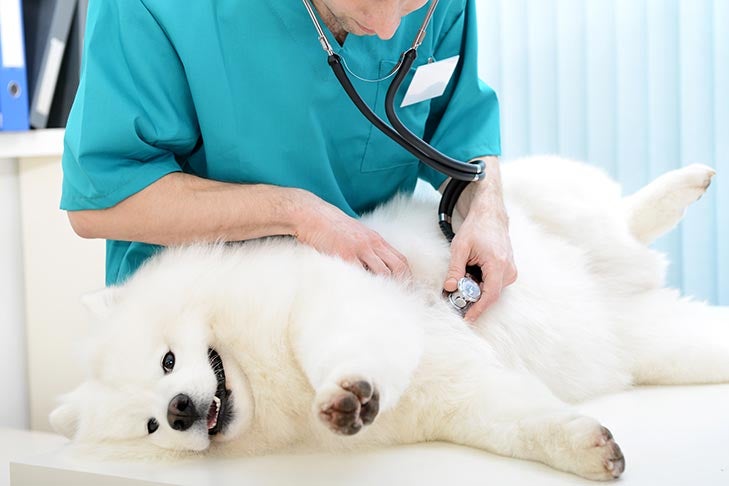How to Tell if a Dog Is Pregnant
Humans have developed instantaneous pregnancy tests that make it easy to determine whether or not we are pregnant. It is not as simple for our dogs. You will most likely need to visit your veterinarian to find out if your dog is pregnant. If possible, be sure to tell your vet exactly when your dog was bred, or your best estimate of the time frame, as all of the pregnancy testing methods for dogs are time sensitive.
There are four methods veterinarians can use to determine if a dog is pregnant:
Veterinarians can test for the hormone relaxin to determine if a bitch is pregnant. Relaxin is released from placental tissue only during pregnancy, which makes it a fairly accurate diagnostic test. However, the bitch must be at least 30 days into her gestation for the test to be accurate. Tests taken before that can have a false negative.
Palpation is the cheapest and most convenient way to diagnose pregnancy. As each fetus develops, the membranes around them grow to form fluid-filled sacs. These sacs can be felt between days 21 and 35 of gestation (approximately three-to-four weeks), and grow to about the size of a table tennis ball in a 45-pound dog. After one month, the sacs lose their distinctive shape, and the uterus develops a floppy feel that can be mistaken for fat or a pyometra.
An x-ray is a great way for breeders to determine how many puppies to expect from their bitch. X-rays are most effective later in pregnancy, as the fetal skull and spine doesn’t become visible on an x-ray until days 42 through 45. Waiting until after day 55 allows veterinarians to give an accurate count of the number of expected puppies and and to determine the best timing for an elective cesarean.
An ultrasound is the best way to find out if a dog is pregnant early on in gestation. Veterinarians recommend ultrasounds between days 25 and 35 of gestation. Ultrasounds not only detect pregnancy, they also determine whether the fetus is alive by registering fetal heartbeats. Ultrasounds can also be used to rule out other causes of uterine distension, like a pyometra, and can help calculate the gestational age of the fetus.

Clubs Offering:
Puppies are exciting. If you are new to breeding, or you are eagerly awaiting the birth of a reserved puppy from a breeder’s litter, the wait can seem eternal. Luckily for us (and for the dog), the gestation period in dogs is much shorter than the gestation period in humans. But exactly how long does a dog’s pregnancy last?
In order to answer the question, “how long are dogs pregnant,” you first need to understand the dog reproductive cycle. Intact female dogs go into heat approximately every six months, although this can vary depending on the dog and the breed. The heat cycle lasts 18-to-21 days and is broken into four distinct stages. Breeders use these stages to determine the best time to breed their dogs.
The four stages of the female dog’s reproductive cycle are:
Proestrus lasts for about 9 days and is the first stage of the reproductive cycle. This is when females start to attract males, although they will reject their advances until stage two. The signs of proestrus are:
Estrus lasts anywhere from 3-to-4 days to 7-to-11 days. This is when the bitch is receptive to the male. Many breeders have a veterinarian take vaginal smears and blood tests during proestrus and estrus to make sure they breed their dogs at the optimal time. The signs of proestrus are:
Diestrus is the final stage of the cycle. It typically occurs around day 14. During diestrus, the bitch’s discharge becomes redder and tapers off, the vulva returns to normal, and she will no longer permit mating. The heat is complete when all signs of swelling and discharge are gone. The time frame between one heat cycle and the next is called anestrus and usually lasts around six months.
Understanding the heat cycle plays an important role in determining the length of pregnancy. Breeders can calculate conception dates by keeping track of their bitch’s heat cycle and breeding period, which makes it easier for veterinarians to accurately test for pregnancy.

It is time for whelping. You may start taking your dogs temperature daily. “A rectal temperature is preferred,” Nielsen says. “Normal is 100.5–102 degrees Fahrenheit. Prior to delivery, her temperature will drop by a few degrees. Thats a sign that labor is very close—it will usually start within 24 hours.” Once labor begins, Nielsen says to keep an eye on your dogs progress, but let nature take its course. “Dont freak her out by having the whole family and all the neighbors over to watch,” she says. “Most often, it all goes off without a hitch.”
Your pregnant dog is now in stage two of her pregnancy. In this stage, the term for her yet-to-be-born puppies changes from embryos to fetuses. As the fetuses continue to grow and develop organs they will increase dramatically in weight (as much as 75 percent!) and your dogs belly will become noticeably larger. You may notice that she starts to eat smaller meals more often throughout the day.
Embryo development is occurring. You may start to notice changes in your dogs appetite and energy levels.
Breeding occurs when the female dog is receptive to the male, usually, 10–20 days into her heat cycle, and her eggs are fertilized. Note that because canine ovulation results in a number of eggs, it is possible for dogs to conceive with more than one father in the same litter of puppies.
You will notice your dogs breast tissue is swollen, her nipples are prominent and dark, and you may notice colostrum, a cloudy fluid known as “first milk” leaking from her nipples. She may start to shed the hair from her belly. You may also be able to see and feel the fetuses move beneath her skin.
Dog Pregnancy Signs week 1 to 9 ! Pet Health
Anyone whos ever been pregnant will be a bit envious after reading this tidbit: A dogs pregnancy is remarkably short—just two months—and the development of puppies happens at a rapid pace. “Gestation is 62 to 65 days,” Lonna J. Nielsen, DVM, of Winterset Veterinary Center in Winterset, Iowa, says. Certainly, you will notice changes in your momma dog, but most of the action is happening to the puppies inside her. Heres a week-by-week timeline of the gestation period.
Note: Be sure to chat with your veterinarian about warning signs you should be on the lookout for during pregnancy and during the delivery (called whelping). You will want to know what things are normal and what is a cause for concern.
Breeding occurs when the female dog is receptive to the male, usually, 10–20 days into her heat cycle, and her eggs are fertilized. Note that because canine ovulation results in a number of eggs, it is possible for dogs to conceive with more than one father in the same litter of puppies.
Once fertilization occurs, the embryos travel into the horns of the dogs Y-shaped uterus and embed into the uterine lining.
Embryo development is occurring. You may start to notice changes in your dogs appetite and energy levels.
By days 25–28 of gestation, a veterinarian can feel the growing embryos with her hands (please leave this exam to a trusted professional so the pregnancy isnt put into jeopardy) and can detect heartbeats with an ultrasound. In the coming days, increasing fluid in the uterus will prevent the palpation of the puppies until closer to delivery. Your dogs appetite will increase as her litters development continues at a remarkable pace.
“Have plenty of food available to her during these high-demand times,” Nielsen says. She also recommends feeding your pregnant and nursing dog a high-quality puppy food to ensure her nutritional needs are met.
Your pregnant dog is now in stage two of her pregnancy. In this stage, the term for her yet-to-be-born puppies changes from embryos to fetuses. As the fetuses continue to grow and develop organs they will increase dramatically in weight (as much as 75 percent!) and your dogs belly will become noticeably larger. You may notice that she starts to eat smaller meals more often throughout the day.
The coats and skeletons of the fetuses are developing as your dogs belly becomes larger and more rigid and she might become uncomfortable depending on how many are in her litter and their sizes.
You will notice your dogs breast tissue is swollen, her nipples are prominent and dark, and you may notice colostrum, a cloudy fluid known as “first milk” leaking from her nipples. She may start to shed the hair from her belly. You may also be able to see and feel the fetuses move beneath her skin.
The puppies are now fully developed and beginning to move into position in the birth canal. You may notice a lot of movement in your dogs abdomen and she may be exhibiting anxiety or a determination to find a safe, quiet place to deliver her litter. Help her build her nest by offering her clean blankets, towels, and/or newspapers in a kiddie pool or crate or another enclosure that gives her privacy and comfort. Keep in mind the bedding in her nest will be ruined during the birth. You will want to have another set of bedding to line the nest after the birth.
It is time for whelping. You may start taking your dogs temperature daily. “A rectal temperature is preferred,” Nielsen says. “Normal is 100.5–102 degrees Fahrenheit. Prior to delivery, her temperature will drop by a few degrees. Thats a sign that labor is very close—it will usually start within 24 hours.” Once labor begins, Nielsen says to keep an eye on your dogs progress, but let nature take its course. “Dont freak her out by having the whole family and all the neighbors over to watch,” she says. “Most often, it all goes off without a hitch.”